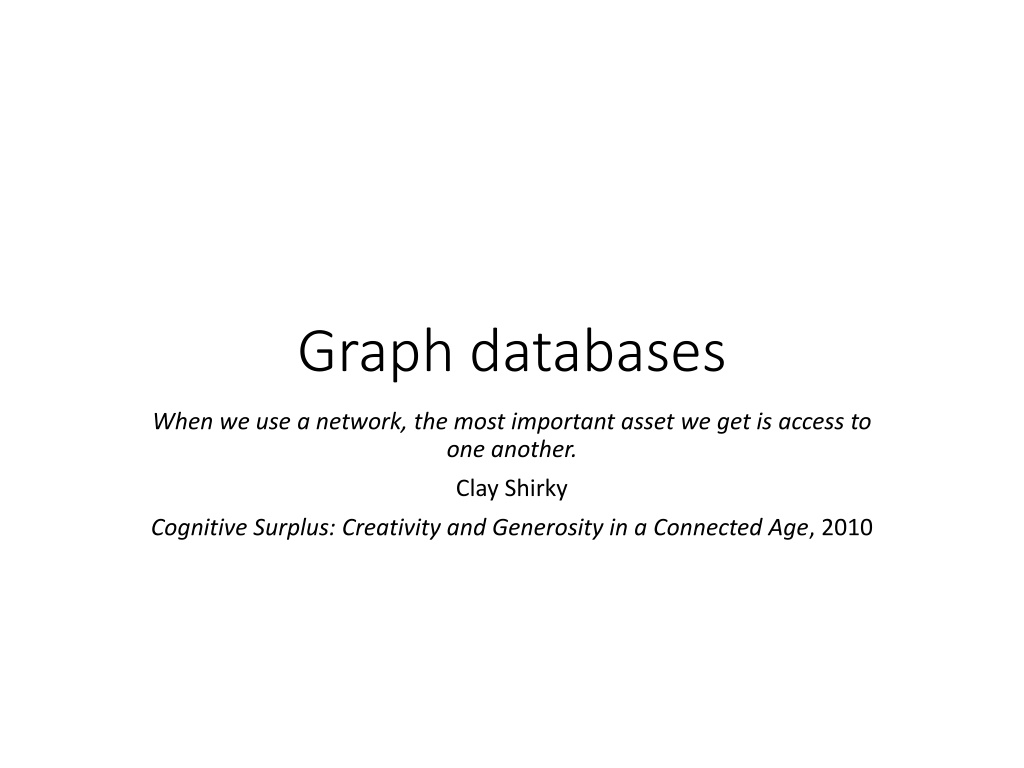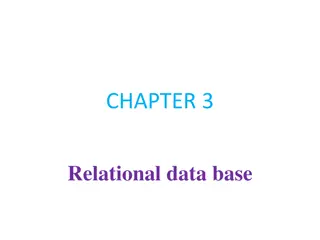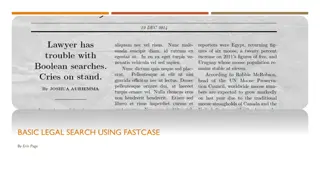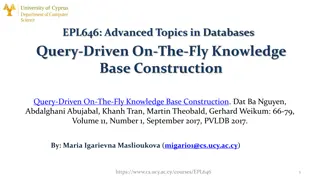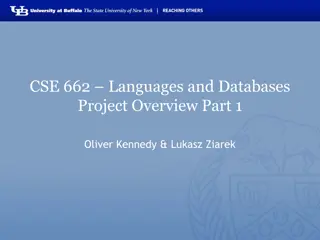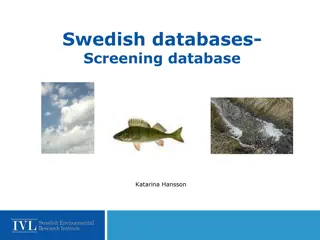Understanding Graph Databases and Neo4j
Graph databases offer a flexible way to manage data by representing relationships between nodes. Neo4j is a popular graph database system that uses Cypher for querying. This guide provides insights into graph database concepts, advantages, and getting started with Neo4j, including creating nodes and populating the database.
Download Presentation

Please find below an Image/Link to download the presentation.
The content on the website is provided AS IS for your information and personal use only. It may not be sold, licensed, or shared on other websites without obtaining consent from the author. Download presentation by click this link. If you encounter any issues during the download, it is possible that the publisher has removed the file from their server.
E N D
Presentation Transcript
Graph databases When we use a network, the most important asset we get is access to one another. Clay Shirky Cognitive Surplus: Creativity and Generosity in a Connected Age, 2010
Graph database A graph is a set of nodes (entities) and edges (relationships) that connect them Nodes and edges can have labels and properties A property graph database A group of nodes with a common label is similar to an entity A node is similar to an instance of an entity A relationship is explicitly defined to connect a pair of nodes In the relational database model, a relationship is represented by a pair of primary and foreign keys
Advantages of a graph database Does not require joins Joins are defined when creating the relationships A graph database is flexible A relationship could change from 1:m to m:m simply by adding relationships New additions can be made without the need to rewrite existing queries or recode applications.
Cypher Cypher is both graph description language (GDL) and graph query languages (GQL) Cypher, like SQL, is a declarative, textual query language, but for graphs. SQL like
Getting started with Neo4j Install Neo4j Desktop https://neo4j.com/download-center/#desktop Mac https://www.youtube.com/watch?v=cTZ_Z3KfLyE Windows https://www.youtube.com/watch?v=RSbhmVF_ccs Set up a database Browser http://localhost:7474
A single node Properties CREATE (:Stock {StockCode: "AR", Firm: "Abyssinian Ruby", Price: 31.82, Qty: 22020, Div: 1.32, PE: 13});
Populate the database LOAD CSV WITH HEADERS FROM "https://www.richardtwatson.com/data/stock.csv" AS row CREATE (s:Stock {StockCode: row.stkcode, Firm: row.stkfirm, Price: toFloat(row.stkprice), Qty: toInteger(row.stkqty), Div: toFloat(row.stkdiv), PE: toInteger(row.stkpe)}) RETURN count(s);
Querying a node Displaying data for nodes with the same label List all Stock nodes MATCH (s:Stock) RETURN s;
Querying a node Reporting properties Report a firm s name and price-earnings ratio. MATCH (s:Stock) RETURN s.Firm AS Firm, s.PE AS PE;
Querying a node Reporting nodes Get all firms with a price-earnings ratio less than 12. MATCH (s:Stock) WHERE s.PE < 12 RETURN s;
Querying a node Reporting properties and nodes List the name, price, quantity, and dividend of each firm where the share holding is at least 100,000. MATCH (s:Stock) WHERE s.Qty > 100000 RETURN s.Firm AS Firm, s.Price AS Price, s.Qty AS Quantity, s.Div AS Dividend;
Querying a node IN for a list of values Report data on firms with of FC, AR, or SLG. MATCH (s:Stock) WHERE s.StockCode IN ['FC','AR','SLG ] RETURN s;
Querying a node Ordering rows List all firms where the PE is at least 10, and order the report in descending PE. Where PE ratios are identical, list firms in alphabetical order. MATCH (s:Stock) WHERE s.PE >= 10 RETURN s.PE AS PE, s.Firm AS Firm ORDER BY s.PE DESC, s.Firm;
Querying a node Derived data Get firm name, price, quantity, and firm yield. MATCH (s:Stock) RETURN s.Firm AS Firm, s.Price AS Price, s.Qty AS Quantity, s.Div/s.Price*100 AS Yield;
Aggregate functions COUNT How many firms are there in the portfolio? MATCH (s:Stock) RETURN count(s);
Aggregate functions AVG What is the average yield for the portfolio? MATCH (s:Stock) RETURN avg(s.Div/s.Price*100) As `Average yield`;
String handling CONTAINS List the names of firms with a double e . MATCH (s:Stock) WHERE s.Firm CONTAINS 'ee RETURN s.Firm;
String handling Subqueries Report all firms with a PE ratio greater than the average for the portfolio MATCH (s:Stock) WITH AVG(s.PE) AS AvgPE MATCH (s:Stock) WHERE s.PE > AvgPE RETURN s.Firm AS FIRM, s.PE as PE;
Specifying relationships in Cypher Relationships are represented in Cypher using an arrow, either -> or <-, between two nodes. In Neo4j, all relationships are directed The Cypher code for stating that Bombay Duck was listed in India on 2019-11-10 is: MATCH (s:Stock), (n:Nation) WHERE s.StockCode = "BD" AND n.NationCode = "IND CREATE (n)-[r:LISTS {Listed: date('2019-11-10')}]->(s) RETURN r;
Add Nation Nodes and Specifying Relationships LOAD CSV WITH HEADERS FROM "https://www.richardtwatson.com/data/nation.csv" AS row CREATE (n:Nation {NationCode: row.natcode, Nation: row.natname, ExchRate: toFloat(row.exchrate)}) RETURN count(n); LOAD CSV WITH HEADERS FROM "https://www.richardtwatson.com/data/stock.csv" AS row MATCH (n:Nation {NationCode: row.natcode}) MATCH (s:Stock {StockCode: row.stkcode}) CREATE (n)-[r:LISTS]->(s) RETURN r;
Querying relationships Report the value of each stockholding in UK pounds. Sort the report by nation and firm. MATCH (n:Nation)-[:LISTS]->(s:Stock) RETURN n.Nation AS Nation, s.Firm AS Firm, s.Price AS Price, s.Qty as Quantity, round(s.Price*s.Qty*n.ExchRate) AS Value ORDER BY Nation, Firm
WITHreporting by groups Report by nation the total value of stockholdings. MATCH (n:Nation)-[:LISTS]->(s:Stock) WITH n, round(sum(s.Price*s.Qty*n.ExchRate)) as Value RETURN n.Nation AS Nation, Value;
Sale Item Relationship Database LOAD CSV WITH HEADERS FROM "https://www.richardtwatson.com/data/item.csv" AS row CREATE (i:Item {ItemNo: toInteger(row.itemno), ItemName: row.itemname, ItemType: row.itemtype, ItemColor: row.itemcolor}) RETURN count(i); LOAD CSV WITH HEADERS FROM "https://www.richardtwatson.com/data/sale.csv" AS row CREATE (s:Sale {SaleNo: toInteger(row.saleno), SaleDate: date(row.saledate), SaleText: row.saletext}) RETURN count(s); LOAD CSV WITH HEADERS FROM "https://www.richardtwatson.com/data/receipt.csv" AS row MATCH (s:Sale {SaleNo: toInteger(row.saleno)}) MATCH (i:Item {ItemNo: toInteger(row.itemno)}) CREATE (s)-[r:CONTAINS]->(i) SET r.Price = toFloat(row.receiptprice), r.Qty = toInteger(row.receiptqty);
Sale Item Relationship Database List the name, quantity, price, and value of items sold on January 16, 2011. MATCH (s: Sale)-[r:CONTAINS]->(i: Item) WHERE s.SaleDate = date('2011-01-16') RETURN i.ItemName AS Item, r.Qty as Quantity, r.Price as Price, r.Qty*r.Price AS Total; MATCH (s: Sale {SaleDate: date('2011-01-16')})-[r:CONTAINS]->(i: Item) RETURN i.ItemName AS Item, r.Qty as Quantity, r.Price as Price, r.Qty*r.Price AS Total;
Does a relationship exist? Does a relationship exist? Report all clothing items (type C ) for which a sale is recorded. MATCH (s: Sale)-[:CONTAINS]->(i:Item {ItemType: 'C'}) RETURN DISTINCT i.ItemName AS Item, i.ItemColor AS Color;
Does a relationship exist? Does a relationship exist? Report all clothing items that have not been sold. MATCH (s: Sale)-[:CONTAINS]->(i:Item {ItemType: 'C'}) WITH COLLECT (DISTINCT i.ItemNo) AS SoldItems MATCH (i: Item) WHERE i.ItemType = 'C' AND NOT (i.ItemNo IN SoldItems) RETURN DISTINCT i.ItemName AS Item, i.ItemColor AS Color; MATCH (i:Item {ItemType: 'C'}) WHERE NOT (: Sale)-[:CONTAINS]->(i) RETURN DISTINCT i.ItemName AS Item, i.ItemColor AS Color;
Recursive relationships Recursive relationships
Recursive relationships Recursive relationships LOAD CSV WITH HEADERS FROM "https://www.richardtwatson.com/data/monarch.csv" AS row CREATE (m: Monarch {Type: row.montype, Name: row.monname, Number: row.monnum}) RETURN count(m); MATCH (p:Monarch), (s:Monarch) WHERE p.Name = 'William' AND p.Number = 'IV' AND s.Name = 'Victoria' AND s.Number = 'I CREATE (s)-[r:SUCCEEDED]->(p) SET r.Date = date('1837-06-20 ) RETURN(r);
Query a recursive relationship Query a recursive relationship Who preceded Victoria I? MATCH (s)-[r:SUCCEEDED]->(p) WHERE s.Name = 'Victoria' RETURN (p.Type + ' ' + p.Name + ' ' + p.Number); Who succeeded Victoria I? MATCH (s)-[r:SUCCEEDED]->(p) WHERE p.Name = 'Victoria' RETURN (s.Type + ' ' + s.Name + ' ' + s.Number);
Query a recursive relationship Query a recursive relationship Who was Elizabeth II s predecessor s predecessor? MATCH (s)-[r:SUCCEEDED*2]->(p) WHERE s.Name = 'Elizabeth' and s.Number = 'II RETURN (p.Type + ' ' + p.Name + ' ' + p.Number);
Query a recursive relationship Query a recursive relationship Who were Elizabeth II s three immediate predecessors? MATCH (s)-[r:SUCCEEDED*1..3]->(p) WHERE s.Name = 'Elizabeth' and s.Number = 'II' RETURN (p.Type + ' ' + p.Name + ' ' + p.Number);
Constraint Constraint To ensure all nation codes are unique CREATE CONSTRAINT ON (n:Nation) ASSERT n.NatCode IS UNIQUE;
Remove duplicates Remove duplicates DISTINCT MATCH (s:Stock) RETURN DISTINCT s.PE AS PE;
Delete all nodes and relationships Delete all nodes and relationships MATCH (a) OPTIONAL MATCH (a)-[r]-() DELETE a, r Match (a) DETACH DELETE a
Exercises The graph database has the following relationships: (order)-[:CONTAINS]->(product) (employee)-[:SOLD]->(order) (customer)-[:PURCHASED]->(order) (supplier)-[:SUPPLIES]->(product) (product)-[:PART_OF]->(category) (employee)-[:REPORTS_TO]->(manager)
Exercises Write Cypher code for the following queries How many employees are there in the company? Prepare a list of employees by last name, first name, and job title. Sort by last name. List the products that contain sauce in their product description.
